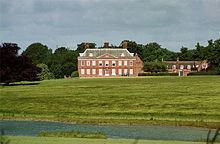 | ||
Hanworth hall cock day 2011
Hanworth Hall is a large late 17th century country house some 500m to the south of the village of Hanworth, Norfolk, England. It is a Grade I listed building.
It is built of brick with stone dressings and a hipped slate roof to a double pile plan. The main eastern facade is in 2 storeys with an attic, and has a 9 bay frontage. The central three bays project under a pediment.
Hanworth Hall had been the seat of the Doughty family from the 15th to the 18th century. The hall was rebuilt after a fire in 1686 for Robert Doughty, who died in 1770 at the age of seventy. His son, Robert Lee Doughty, began to lay out the park later that year with assistance from his friend, the landscape designer Humphry Repton. Repton worked at the site from 1789 to 1790. Within the grounds of the hall there is a notable Spanish chestnut tree which is thought to be over 300 years old.
Robert died with no heirs and the estate passed to the children of his sister Catherine and her husband George Lukin passing in turn to Philip Wynell Mayow (died 1845), then William Howe Windham, MP, (son of Vice Admiral William Lukin Windham) and then the latter's son W.F. Windham. At the end of the century, financial pressures caused the house to be sold in 1900 to Joseph Gurney Barclay for his third son, Army officer Henry Barclay, aide-de-camp to King Edward VII (1906–10) and King George V (1910-25). Henry's descendant, the millionaire Michael Barclay, was convicted and gaoled in 2006 for wildlife offences.
